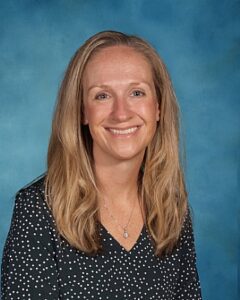Third Grade

Kathryn McHale - 3A
k.mchale@stjoansk-8.org
Third Grade Curriculum
Religion
A student will be able to:
- understand and appreciate the four marks of the church
- understand and appreciate our beliefs about God the Father, Jesus His Son, and the Holy Spirit
- understand and explain what prayer is and what the sacraments of initiation, healing, and vocation mean to Catholics
- understand and appreciate the Church's ministries of community building, of the Word, of worship, and of service
- recite and comprehend the Apostle’s Creed
Social Studies
A student will be able to:
- understand how communities are alike and different
- recognize the importance of resources to a community
- understand that community and government provide us with different laws and services
- explore how people relocate to different communities in search of different/better opportunities
- use map and globe skills: direction, compass rose, map key, land forms, latitude/longitude, and infographic sources
- practice good citizenship
- practice using thinking and study skills
Language Arts
A student will be able to:
- participate in daily shared reading of different forms of literature: poetry, plays, fiction, and non-fiction
- read a selection to his/her classmates
- consistently apply decoding strategies - prefixes, suffixes, possessives, contractions, present, past, and future verb tenses
- consistently apply vocabulary strategies - synonyms, antonyms, homophones, homographs, context clues, summarize, sequence, and predict outcomes
- develop comprehension monitoring strategies, - identify topic sentences and supporting sentences
- identify literary elements: idioms, plot, setting, mood, and character
- write a report/give oral presentations based on a topic
- identify sources for finding specific types of information
Math
A student will be able to:
- solve problems involving classification, ordering, graphing, number sentences, probability, and statistics
- rewrite three and four digit numbers in standard, expanded, and word forms
- complete two and three digit addition and subtraction problems with regrouping
- apply skills of estimation
- understand the concept of multiplication and division
- use mental math involving multiplication and division facts of zero through twelve times table
- explore the concept of equivalent fractions
- identify geometric shapes and concepts
- explore different forms of measurement
- introduce decimals and their place value
Science
A student will be able to:
- identify and describe basic characteristics of living things
- understand how the Sun, Earth, and Moon influence one another
- understand that the Earth's surface and rocks are continually changing as a result of geologic process
- investigate forces and how they relate to motion
- recognize the simple machines around them
- explore the concepts of energy
Art
A student will be able to:
- use the design elements of line, shape, color, texture, and space
- explore art history and some famous works of art
Computer
A student will be able to:
- save and retrieve a file on our Network
- insert a graphic
- print a file
- search the internet
- use a variety of computer programs to enhance skills in other subject areas
Library
A student will be able to:
- visit weekly and check out a library book for enjoyment reading and a book to supplement classroom assignments
- use the Dewey Decimal System
- use all library skills taught
Music
A student will be able to:
- read and perform rhythms by moving, dancing, and playing instruments
- sing in harmony using round s and partner songs
- sing and praise God with Church songs
Physical Education
A student will be able to:
- practice sport skills through participation in lead-up and recreational games explore locomotor movements with added complexity in sequential patterns
- participate in sport lead-up games - soccer, basketball, volleyball, and baseball
Spanish
A student will be able to:
- state the days of the week, months, and seasons of the year in Spanish
- Introduce themselves and others in Spanish
- Play games and sing songs in Spanish
- identify: colors, numbers zero to fifty, foods, clothing, the face, animals, classroom objects, family, community, and the Spanish alphabet
